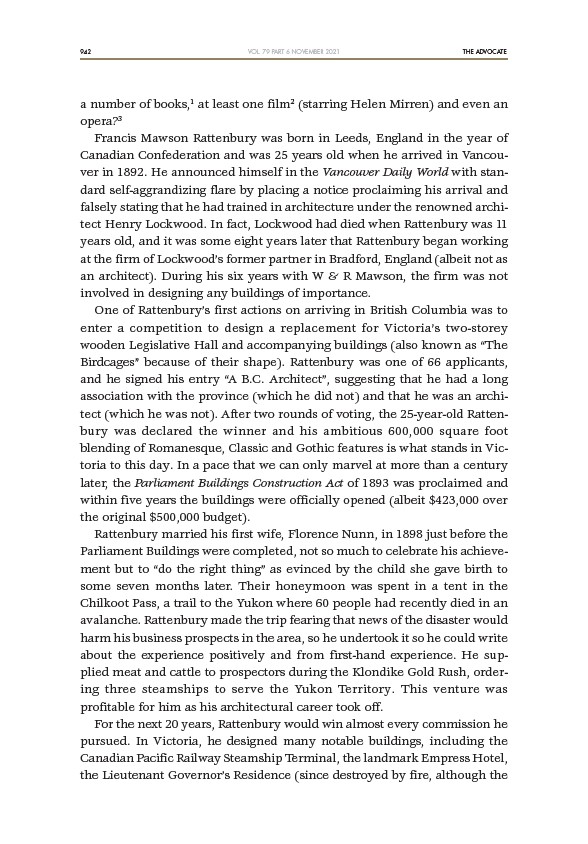
942 THE ADVOCATE
VOL. 79 PART 6 NOVEMBER 2021
a number of books,1 at least one film2 (starring Helen Mirren) and even an
opera?3
Francis Mawson Rattenbury was born in Leeds, England in the year of
Canadian Confederation and was 25 years old when he arrived in Vancouver
in 1892. He announced himself in the Vancouver Daily World with standard
self-aggrandizing flare by placing a notice proclaiming his arrival and
falsely stating that he had trained in architecture under the renowned architect
Henry Lockwood. In fact, Lockwood had died when Rattenbury was 11
years old, and it was some eight years later that Rattenbury began working
at the firm of Lockwood’s former partner in Bradford, England (albeit not as
an architect). During his six years with W & R Mawson, the firm was not
involved in designing any buildings of importance.
One of Rattenbury’s first actions on arriving in British Columbia was to
enter a competition to design a replacement for Victoria’s two-storey
wooden Legislative Hall and accompanying buildings (also known as “The
Birdcages” because of their shape). Rattenbury was one of 66 applicants,
and he signed his entry “A B.C. Architect”, suggesting that he had a long
association with the province (which he did not) and that he was an architect
(which he was not). After two rounds of voting, the 25-year-old Rattenbury
was declared the winner and his ambitious 600,000 square foot
blending of Romanesque, Classic and Gothic features is what stands in Victoria
to this day. In a pace that we can only marvel at more than a century
later, the Parliament Buildings Construction Act of 1893 was proclaimed and
within five years the buildings were officially opened (albeit $423,000 over
the original $500,000 budget).
Rattenbury married his first wife, Florence Nunn, in 1898 just before the
Parliament Buildings were completed, not so much to celebrate his achievement
but to “do the right thing” as evinced by the child she gave birth to
some seven months later. Their honeymoon was spent in a tent in the
Chilkoot Pass, a trail to the Yukon where 60 people had recently died in an
avalanche. Rattenbury made the trip fearing that news of the disaster would
harm his business prospects in the area, so he undertook it so he could write
about the experience positively and from first-hand experience. He supplied
meat and cattle to prospectors during the Klondike Gold Rush, ordering
three steamships to serve the Yukon Territory. This venture was
profitable for him as his architectural career took off.
For the next 20 years, Rattenbury would win almost every commission he
pursued. In Victoria, he designed many notable buildings, including the
Canadian Pacific Railway Steamship Terminal, the landmark Empress Hotel,
the Lieutenant Governor’s Residence (since destroyed by fire, although the